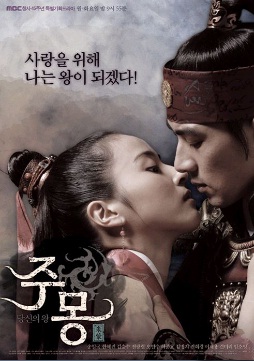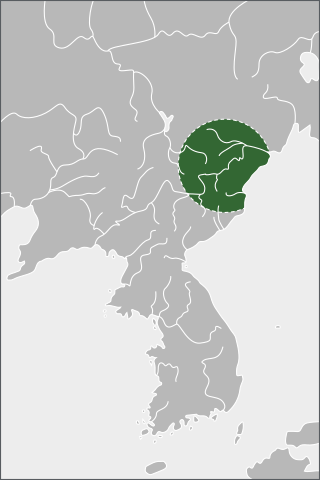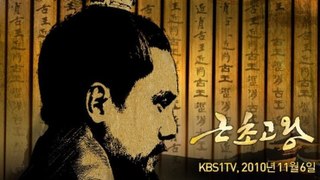
Muryeong of Baekje was the 25th king of Baekje, one of the Three Kingdoms of Korea. During his reign, Baekje remained allied with Silla against Goguryeo, and expanded its relationships with China and Japan. It is recorded that King Muryeong was 8 feet tall and had green-like eyes.

Baekje or Paekche was a Korean kingdom located in southwestern Korea from 18 BC to 660 AD. It was one of the Three Kingdoms of Korea, together with Goguryeo and Silla. While the three kingdoms were in separate existence, Baekje had the highest population of approximately 3,800,000 people, which was similar to that of Goguryeo and much larger than that of Silla.
Uija of Baekje was the 31st and final ruler of Baekje, one of the Three Kingdoms of Korea. His reign ended when Baekje was conquered by an alliance of the rival Korean kingdom Silla and China's Tang dynasty.
Asin of Baekje was the seventeenth king of Baekje, one of the Three Kingdoms of Korea.

Chumo, posthumously Chumo the Saint, was the founding monarch of the kingdom of Goguryeo, and was worshipped as a god-king by the people of Goguryeo and Goryeo. Chumo was originally a Buyeo slang for an excellent archer, which became his name later. He was commonly recorded as Jumong by various Chinese literatures including history books written by Northern Qi and Tang—the name became dominant in future writings including Samguk Sagi and Samguk Yusa. Chumo's title was changed to Dongmyeong the Saint, literally translated to the Brilliant Saintly King of the East, at some point of time prior to compilation of Samguk Sagi (1145). His other names include Chumong, Jungmo, Nakamu, or Tomo. In Samguk Sagi, he was recorded as Jumong with the surname Go, and was also known as Junghae or Sanghae.
King Daemusin was the third ruler of Goguryeo, the northernmost of the Three Kingdoms of Korea. He led early Goguryeo through a period of massive territorial expansion, conquering several smaller nations and the powerful kingdom of Eastern Buyeo.

Jumong is an epic South Korean historical series that aired on MBC from 2006 to 2007 as the network's 45th anniversary special. Originally scheduled for 60 episodes, MBC extended it to 81 because of its popularity.

Hae Geumwa was the second ruler of Dongbuyeo, an ancient kingdom of Korea. His story is recorded in Samguk Sagi, Samguk Yusa and Book of King Dongmyeong.

Eastern Buyeo, also rendered as Dongbuyeo or Eastern Fuyu, was an ancient kingdom that developed from Northern Buyeo, until it was conquered by Goguryeo. According to the Samguk Sagi, it was established when the Buyeo king Hae Buru moved the capital eastward by the sea.
The Go Royal Family was the dynasty that founded and ruled over the ancient Korean kingdom of Goguryeo. Its founder, Jumong, broke away from another ancient Korean kingdom called Dongbuyeo to start his own kingdom. The Taewangs were all members of the Go Royal Family.
Soseono or Yeon Soseono was the second wife of King Dongmyeong and a key figure in the establishment of both Goguryeo and Baekje. She was the mother of Biryu and Onjo, whom they were her sons from her first marriage with Wutae.
Hae Daeso was the third and last ruler of the ancient Korean kingdom Dongbuyeo.

The King of Legend is a 2010 South Korean historical drama based on King Geunchogo of Baekje. Besides historical information from Samguk Sagi and Samguk Yusa, it was also inspired by a novel written by Lee Munyeol, a renowned Korean writer. The drama aired on KBS1 in Korea, and internationally through KBS World.
Ji-young Kim is a South Korean prima ballerina and is currently a principal dancer with the Korea National Ballet (KNB) in Seoul, South Korea.

Ja Myung Go is a 2009 South Korean television series starring Jung Ryeo-won, Park Min-young and Jung Kyung-ho. It aired on SBS from 9 March to 21 July 2009 on Mondays and Tuesdays at 21:55 (KST) for 39 episodes.
The Korean legend of Prince Hodong and the Princess of Nakrang is the story of a Princess who betrays her own country for the love of a Prince of the enemy country. This story is set during the reign of Daemusin of Goguryeo, first mentioned in the Samguk Sagi (삼국사기). It records that Nakrang had a sacred drum and trumpet that sounded by themselves in case of foreign invasion called the Jamyunggo. To invade Nakrang, King Daemusin ordered his son, Prince Hodong, to deceive the Princess of Nakrang into tearing apart the mystical drum and flute, resulting in the fall of Nakrang. This tale of warring nations, love, betrayal, and death and has been the topic of many dramatizations and philosophical comments.
Prince Hodong was a Goguryeo Royal Prince as the son of King Daemusin, from Lady Hae.
According to the ancient Korean record of Samguk Sagi, Choi Ri was the king of Nakrang Kingdom. However, the kingdom's sovereignty is disputed along with Choi Ri's title. Many Korean scholars view Nakrang as an independent kingdom and Choi Ri as Nakrang's king, but Chinese and Japanese scholars usually claim that the name Nakrang referred to Lelang Commandery and Choi Ri was a Chinese governor of the commandery.
According to the ancient Korean record of Samguk Sagi, the Princess of Nakrang was a daughter of Choi Ri who was the king of Nakrang Kingdom. However, the kingdom's sovereignty is often disputed, which is often viewed as an independent kingdom by Korean scholars while Chinese and Japanese academic communities usually interpret the name Nakrang to be referring to Lelang Commandery.
Nakrang Kingdom was a kingdom located in the northwestern part of the Korean Peninsula according to Samguk Sagi. The kingdom's independence, however, is debated. According to the ancient Korean record of Samguk Sagi, the King of Nakrang named Choi Ri met the Prince Hodong of Goguryeo and let him marry his daughter, the Princess of Nakrang. When Prince Hodong asked the princess to break drums and horns in the Nakrang's armory to prevent the kingdom's guards from alerting the attack by Goguryeo, the princess followed Hodong's instructions, leading to Nakrang being conquered by Goguryeo.







